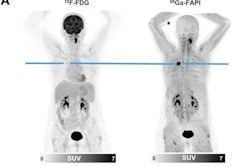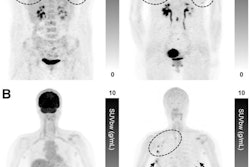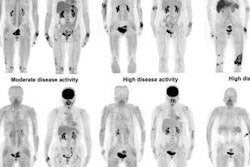FAPI radiotracer uptake on PET/CT imaging may be a biomarker for identifying early responders to rheumatoid arthritis (RA) treatment, according to a study published January 4 in EJNMMI Research.
In a small study, gallium-68 (Ga-68) FAPI-04 uptake at baseline was significantly higher in early treatment responders than in non-responders, with the finding suggesting the approach identifies subclinical inflammation, noted corresponding author Yaping Luo, MD, of the Chinese Academy of Medical Sciences and Peking Union Medical College Hospital in Beijing, and colleagues.
“The expanding array of drugs available for treating RA is creating challenges in drug selection for the individual patient. Some of the patients do not have good response to these drugs,” the group wrote.
Rheumatoid arthritis (RA) is a chronic autoimmune inflammatory disease that primarily involves synovial joints. Early use of disease-modifying antirheumatic drugs (DMARDs) is essential to the good control of synovitis and prevention of joint injury, the authors explained.
Fibroblast activation protein (FAP) has been shown to bind to overexpressed synovial fibroblasts in rheumatoid disease models, with FAP radiotracers labeled with Ga-68 serving as radiotracers that reveal this activity on PET imaging.
In a previous clinical trial, Luo and colleagues showed that Ga-FAPI-04 PET/CT is effective for assessing joint disease activity in RA patients. In this study, they further analyzed data from 19 patients to determine whether FAPI-PET could help predict treatment responses.
All of the patients had high or moderate disease activity and underwent PET/CT exams at baseline, as well as standard F-18 FDG PET/CT scans for comparison. Subsequent treatments included conventional DMARDs (including methotrexate, leflunomide, cyclophosphamide, and tripterygium wilfordii), and synthetic DMARDs (including etanercept, adalimumab, and Janus Kinase inhibitors). Six patients received additional prednisone, and six patients had nonsteroidal anti-inflammatory drugs.
 Representative Ga-68 FAPI-04 and F-18 FDG-PET/CT images of responders at three month follow-up. Patient #11 was a 50-year-old man with 28 affected joints detected in PET/CT. Joint activity decreased after treatment with Tripterygium wilfordii, methotrexate, adalimumab, and prednisone. In patient #8 (a 65-year-old woman), Ga-68 FAPI-04 PET/CT showed 12 affected joints. Joint activity decreased from baseline after three months of treatment with Tripterygium wilfordii and methotrexate.Image courtesy of EJNMMI Research
Representative Ga-68 FAPI-04 and F-18 FDG-PET/CT images of responders at three month follow-up. Patient #11 was a 50-year-old man with 28 affected joints detected in PET/CT. Joint activity decreased after treatment with Tripterygium wilfordii, methotrexate, adalimumab, and prednisone. In patient #8 (a 65-year-old woman), Ga-68 FAPI-04 PET/CT showed 12 affected joints. Joint activity decreased from baseline after three months of treatment with Tripterygium wilfordii and methotrexate.Image courtesy of EJNMMI Research
According to the data, 11 patients were responders (major response in two patients, moderate response in four patients, and minor response in five patients), and eight patients were non-responders. Both baseline Ga-68 FAPI-04 and FDG F-18 FDG radiotracer were higher on PET/CT in responders versus nonresponders, with Ga-68 FAPI-04 showing higher uptake than F-18 FDG, the authors noted.
After three months of treatment, Ga-68 FAPI-04 baseline tracer uptake levels in total joints, for instance, predicted patient responders with an area under the operating curve (AUC) score of 0.83, a sensitivity of 80%, and a specificity of 78%, according to the findings. Moreover, clinical, nonimaging characteristics of disease activity at baseline did not show significant difference between the responders and non-responders, the authors noted.
“We think higher uptake of Ga-68 FAPI-04 and F-18 FDG before treatment suggested more activated inflammation of synovitis, thus indicated better reaction to systemic mediators against inflammation and better clinical response,” the group wrote.
Ultimately, the study warrants prospective studies with specific therapeutic regimens to further investigate the role of Ga-68 FAPI-04 PET in the prediction and response evaluation, the authors concluded.
The full study can be found here.




















